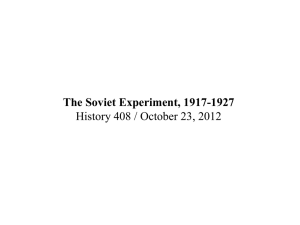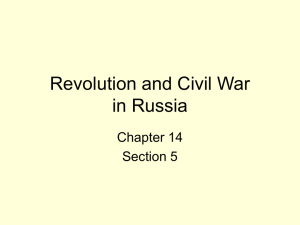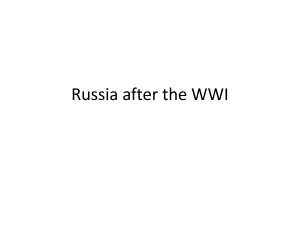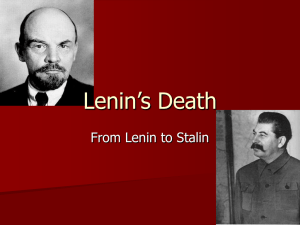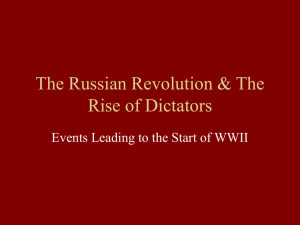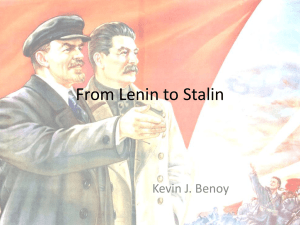The Lenin Legacy for Stalin
advertisement
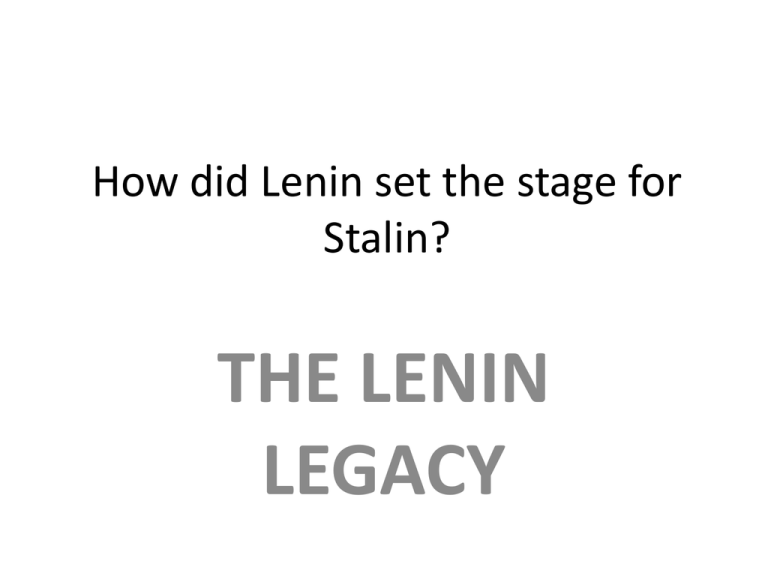
How did Lenin set the stage for Stalin? THE LENIN LEGACY Stalin became heir to the “Lenin legacy” Since 1924 Lenin’s body has been kept on display in his Mausoleum on Red Square, right outside of the Kremlin walls. Lenin’s Legacy “It is barely an exaggeration to say that in the eyes of the Communist Party, Lenin became a god. His actions and decisions became unchallengeable, and all arguments and disputes within the Party were settled by reference to his statements and writings.” (Lynch 16) Lenin’s Legacy • Soviet Communism became Leninism • Thereafter, leaders had to at least appear to carry on his work. Key Dates: • • • • • • • • • • • 1917 1917 1917-1924 1918 1918-1920 --1921 1922 1923 1924 February Revolution October Revolution Consolidation of Bolshevik power Decree Separating Church & State Russian Civil War Foreign Interventions The Red Terror Ban on Factionalism Purges and show trials Lenin’s Testament Death of Lenin Lenin Provided the Ideological Base • Foundations in Marxist beliefs • According to Lenin, Bolsheviks were guiding the proletariat through the scientific laws of the dialectic, to cease power. • Lenin believed that that workers could not complete the revolution without strong, central, and elite leadership. Cease power in the October Revolution, 1917 Soviets- local committees Lenin’s Bolsheviks, with the support of the Soviets, overthrew the Provisional Government Civil War- 1918-1920 The Reds –vs- The Whites Foreign Intervention- USA, Great Britain, France The Communist Party had taken absolute control Lenin’s Methods establish precedent in the party… A. The Red Terror -Lenin allowed NO opposition government -Established a “tradition of authoritarian rule for the communist party.” (Lynch 2) -Established the Cheka (1st Secret Police of the party) -Established the Red Army- Army loyal to Lenin via Trotsky ESSENTIALLY THE BOLSHEVIK GOVERNMENT REPLACED ONE FORM OF TOTALITARIAN / AUTHORITARIAN GOVERNMENT WITH ANOTHER Lenin needed to reject the Tsarist past… B. Democratic Centralism -To appear less “authoritarian” Lenin was careful to describe the policies of the government as democratic -” Democracy is indispensable to socialism.” – Lenin -Goal- To direct the revolution from above. Lenin’s Definition of Democratic Centralism: • “Classes are led by parties, and parties are led by individuals who are called leaders. This is the ABC. The will of a class is sometimes fulfilled by a dictator. Soviet socialist democracy is not in the least incompatible with individual rule and dictatorship. What is necessary is individual rule, the recognition of the dictatorial powers of one man. All phrases about equal rights are nonsense.” -Lenin CPSU- Communist Party of the Soviet Union C. Established the precedents of Authoritarianism • Represented a return to absolutism 1917-1924 1. Single Party State 2. Bureaucratic Organization- government organizations grew, structure was created 3. Police State- the Cheka 4. Ban on factionalism- 1921 by Lenin- outlawed criticism of the leadership within the Party. Ban of free speech. C. Established the precedents of Authoritarianism • Represented a return to absolutism 1917-1924 5. Destruction of Trade Unions- Trotsky removed all trade unions. 6. Law used to extend the power of the state…. Not to protect people. “The Court is not to eliminate terror but to legitimize it.”- Lenin 7. Purges- Created under Lenin -by 1924 there were 315 concentration camps to hold White prisoners of war, rebel peasants, and political prisoners C. Established the precedents of Authoritarianism • Represented a return to absolutism! 1917-1924 8. Show Trials--Public Trials of the Moscow clergy, April –July 1922 --Public Trials of the Socialist Revolutionaries (SRs) as a Threat to Soviet security and order 9. Prohibition of Public Worship- Orthodox churches were looted and closed. Clergy arrested. -Atheism adopted to replace religious belief -Karl Marx - Religion is the “Opium of the people.” -Lenin argued that religion existed to deaden the pain of life. -January 20, 1918- Decree on Separation of Church & State No salaries to church members, no church schools, no ownership of the Church lands (now state controlled) D. New Economic Policy (NEP) • Lenin had implemented “war communism” during the Civil War to help secure the win – Central control of Agriculture, food seized, farming for profit prohibited, traditional markets were outlawed. • NEP– – – – – – – (Gosplan- government body for Economic Planning) Central control to be relaxed Agriculture, farming - free enterprise Allowed to sell surpluses for profit Public markets restored Money introduced for trade “Temporary concession to capitalism.” Left Communists- Wanted the NEP abandoned • Trotsky spoke out against – Right Communists- Wanted to continue the NEP • Stalin would use Trotsky’s opposition to the NEP as justificationTrotsky was disrupting the Party structure… of course Stalin would alter abandon the NEP altogether once he gained control. Research Piece: a. b. c. d. e. Trotsky Kamenev Zinoviev Bukharin Stalin 1. 2. 3. 4. 5. Read and research your person What are your beliefs? What is your position? What is your relationship to Lenin? What do you do in the months after Lenin’s death? 6. What are your motivations?
